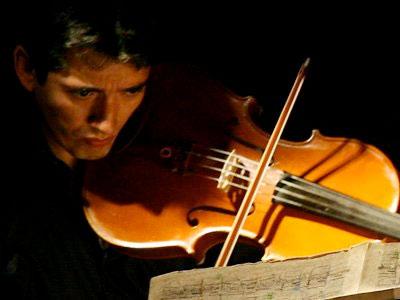A modernist tribute to a murdered young musician

In June of this year, Omar Hernández-Hidalgo was brutally murdered in his hometown of Tijuana, the Mexican violist a victim of the escalating violence and bloodshed in his country.
The gifted young musician was remembered Wednesday night by the International Contemporary Ensemble in a program of new works composed by three of Hidalgo’s compatriots and devoted to his memory.
The three world premieres at the Museum of Contemporary Photography, were interspersed with taped reminiscences of Hidalgo by his friend, flutist and composer Wilfrido Terrazas. Oddly, none of the works performed utilized Hidalago’s instrument, the dark tone of which would have seemed natural for an homage.
Befitting’s ICE’s envelope-pushing aesthetic, the music avoided any traditional dirge-like valedictory lament, preferring to mark Hidalgo’s passing in a more edgy and individual fashion.
Ivan Naranjao’s Maquina Esquiza III opened the evening. Scored for violin, flute and clarinet, Naranjo’s piece begins and ends with the flutist and clarinetist (Claire Chase and Joshua Rubin)creating breathy wind-like sounds against pointillist violin notes. The fragments coalesce and become more defined, with notes growing longer and more concentrated. There are some striking effects here — including the tenebrae-like descending violin motif played by David Bowlin and some sense of meditative solace. Yet Naranjo’s music turns rather shapeless and over-extended with its repeated rests and repetitions.
The Canto funebre movement from Samuel Cedillo’s Trio No. 1 (also for flute, clarinet and violin) opens with a blues-tinged clarinet solo with folk-like leaps. Rubin’s clarinet is contrasted here against Bowlin’s violin, the former playing long, mournful wails set against jagged, acid-tinged violin sounds, including those by bowing the instrument under the bridge. The horrific violence in Mexico seems to be characterized in the violin’s spiky astringencies while the clarinetist and later flutist (Eric Lamb) represent a besieged human voice struggling against the harsh desolation.
Death and Time by Edgar Guzman closed the program. Scored for amplified solo violin, the work appears to symbolically reflect the silencing of Hidalgo’s voice and music. At the opening, Bowlin bows the strings while completely muting them with his left hand, the slight noise, his breathing and occasional scrape simultaneously amplified and manipulated live.
With an unearthly array of sounds produced by unorthodox means — at one point, Bowlin bows the side of his instrument — the wooden crackles, high harmonics and jarring distortions provided an aptly unsettling sonic landscape. Hidalgo, a committed advocate for contemporary music, would no doubt have approved.
Posted in Performances


